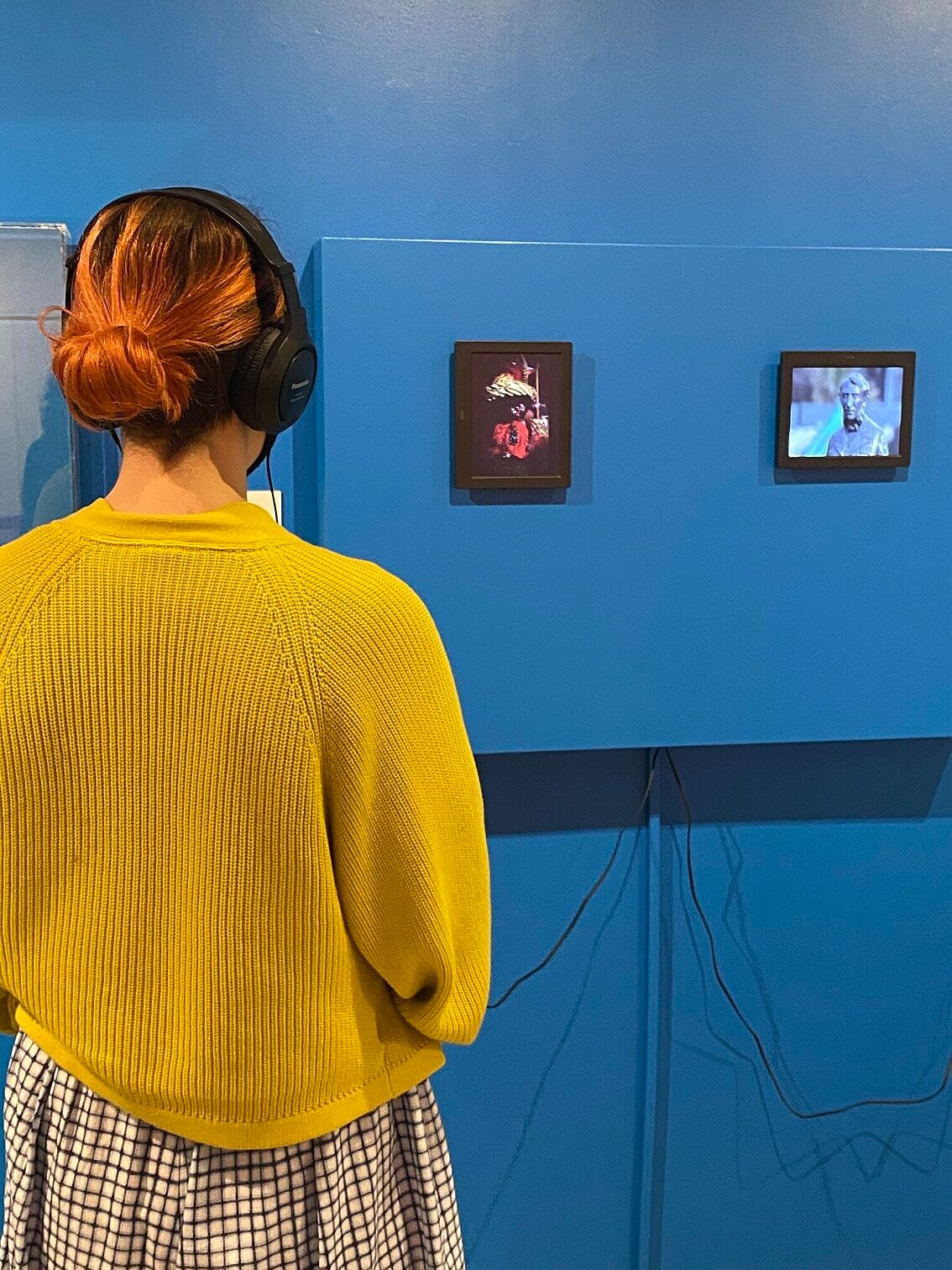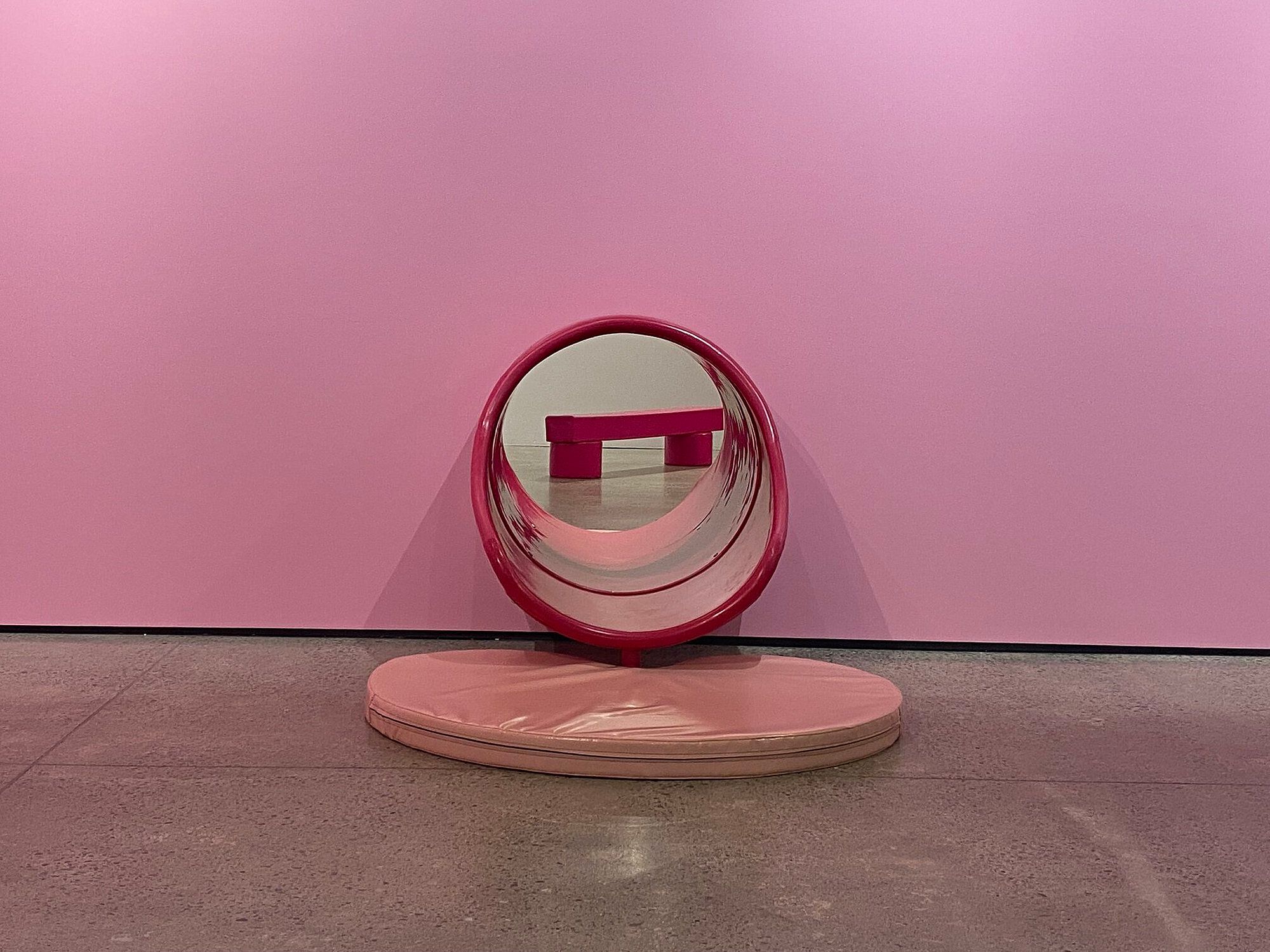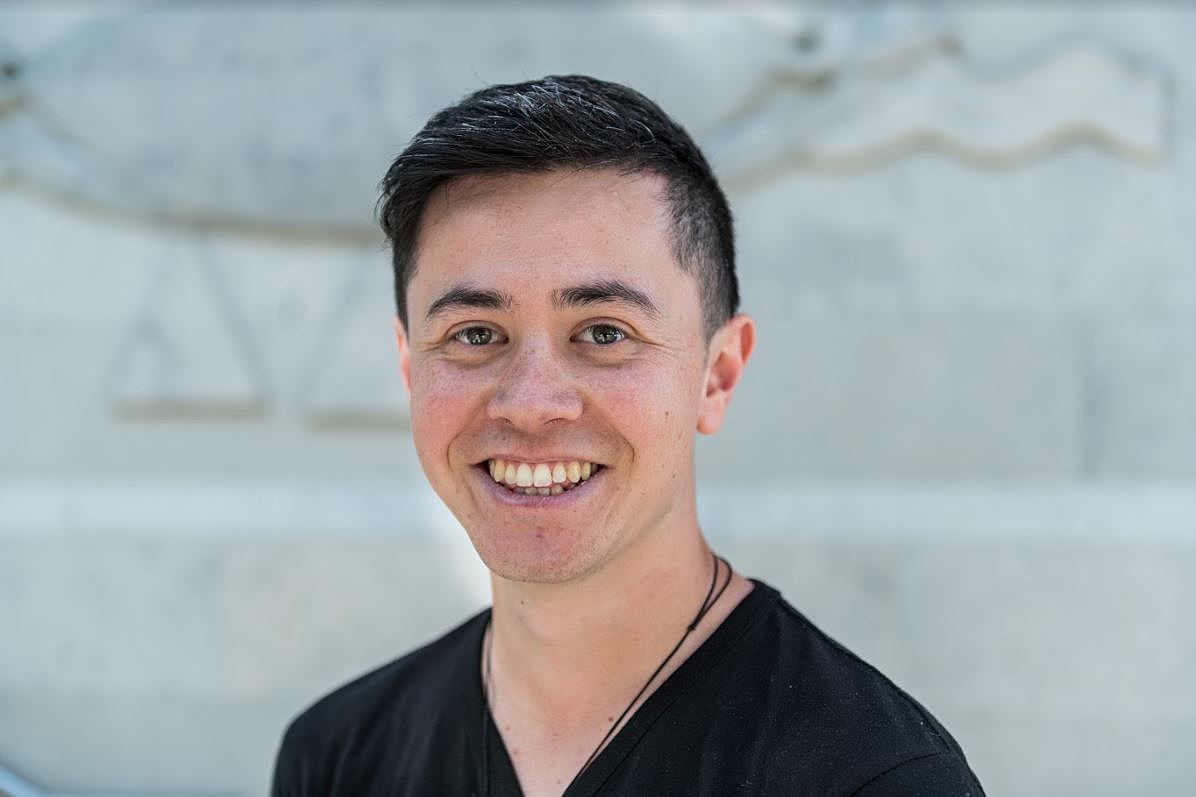Trickster's Playground
The trickster tales of Māui the atua defiantly question our country's historical past in Mischief Makers.
Once upon a time, a group of brothers set out to go fishing. They tried to go without their brother Māui-tikitiki-a-Taranga. Māui hid in the bottom of his brothers' waka, quiet as they took off out to sea. Far from the land, he sprang out and surprised them.
You can't forget about me!
Once upon a time, there was a young country called New Zealand, whose population seemed to keep forgetting about their past. Yet in the busy cities and rural regions of the land were people that have long been here, and refuse to remain silent about the past.
He ao, he ao, he Aotearoa, you won't forget about this.
Mischief Makers, Pātaka Art + Museum, installation view. Photo: Elias Rodriguez / Mark Tantrum Photography
werrrrr…
The glass door to the exhibition space opens, and before anything else happens, I hear, "Uncle Noogy… what are you doing here?" The voice comes from a familiar cartoon playing on a large screen installed on a constructed wall in the centre of the room. I move closer to watch. I've arrived just in time for a quick clip of The Militant Uncle Cooking Show.
Uncle Noogy Hook is the discerning yet cheeky family member of the Hooks, the lead whānau of the television show Aroha Bridge, created and written by Jessica Hansell. While preparing a meal, Uncle Noogy provides a Motis test1 of New Zealand historical context in this short clip.
Nā reira ka tapahi ngā kāreti pēnei a Hone Heke tapahi ana i te pou kara a Waitangi i te tau kotahi mano waru rau whā tekau mā whā. A pēnei a Heke me toru ngā kāreti te tūpono nā te mea kāore a Heke i tū ōu te tikanga e kore hoki koe i pērā.
Now I'm going to slice carrots like Hone Heke chopped down the British flagpole at Waitangi in 1844. Like Heke, be sure to have three more carrots as backup because Heke never gave up fighting, and neither should you.
I read ‘Fire Chief Fire Thief’, and began thinking about the tricky Māui again
Across the wall to my left is a vinyl mural with Uncle Noogy and some of the other characters from Aroha Bridge standing together in a harmonious spectrum that is both blasé and valiant. On the left is Monty Hook – known to be laid back, he stands in a knock-kneed stance with a puzzled expression. Kōwhai Hook, the go-getter sister of Monty, dressed in a mustard yellow jumpsuit – she has also donned a judge’s periwig, and is holding a briefcase in her right hand, her left hand raised. To the right is Tapi – witty and streetwise, he has a loudspeaker next to him, at the ready to egg on the protest. They all look toward Uncle Noogy. Behind them are protest signs reading ‘Honour the Treaty’ and ‘Still Waiting’. At their feet sits a fire extinguisher labelled ‘flame away’, no doubt in preparation for their next hijinks. It gets a shameless snigger out of me, and I start to wonder what role this show plays in the exhibition.
I turn around and look at the floating transparent Perspex panel I walked past on the way in, which is overlaid with text. I read ‘The Trickster Manifesto’, authored by Natalie Robertson, Hemi Macgregor and Danny Butt, a list originally published in the essay ‘The 10 Predicaments of Māui’. ‘The Trickster Manifesto’ lists the trickster’s names and offers a selection of identifiable trickster traits. Nine lines down, I read ‘Fire Chief Fire Thief’, and began thinking about the tricky Māui again.
Can I have the last of your toenails, Māhuika? The fires are out back home?
Māui, I gave you my other nine. What have you done with them?
Layne Waerea, Māori Lane, 2012
Next, I’m drawn towards a screen displaying footage of a figure darting out onto the road to stencil the words “MAORI LANE” on the asphalt. The artist Layne Waerea presents this footage, paired with scribed text, as a point of discussion, the artwork’s existence making space for a "privileged lane for Māori". Layne draws in passers-by so they stop and consider this new road signage, luring them into a conversation on Māori legal rights relating to freshwater ownership.
Challenging artistic, societal and legal boundaries through real-time performance is a tricky business, also one that Māui was well acquainted with. His fateful actions of casting the jaw bone of his kuia Murirangawhenua into the depths of the ocean and hauling forth the land we call Te Ika-a-Māui had no practice or rehearsal.
Māui was well acquainted with challenging societal boundaries
As a real-time performance artwork, Layne filmed her actions on the street, and the interactions of people who walked past. There is the fear of being hit by cars, the police arriving, yet she finishes stenciling each letter, stops her camera recording and ends the artwork. In making this work Layne risks being caught in the web of real-world laws. As both artist and performer, Layne doesn't have a support crew in case of interference.
By now, I can see that motives of defiance are the name of the game in Mischief Makers. The atua Māui, Aroha Bridge, Natalie, Hemi, Danny, and now Layne, have me pondering the big questions. How do we provoke discussions of nationhood? How do we promote ways of protecting our community's enjoyment of Aotearoa New Zealand, and recognise and provide for the continuous fostering of Māori with their culture, customs and taonga?
Suzanne Tamaki, Taonga Talkback TV, 2020, installation view. Photo: Elias Rodriguez / Mark Tantrum Photography
Call in the Trickster
A messenger in transit … the anarchist who challenges governance and societal structure … the defender of deeply held cultural values.2
I continue my walk through the exhibition, enter the second room and move toward a line of iPads and headphones. Suzanne Tamaki’s video works Taonga Talkback TV introduce me to a variety show of interview snippets with animated TAONGA. Recorded in lockdown and first shared on Facebook, Tamaki's A+ artworks are animation and imagination with a bit of cheeky truth as education.
Names deserve bravery. Putting the headphones on, the first interview presents Miss Tiki. She asks for her name to be pronounced correctly and has every right to do so. If you find yourself meeting someone with a name you haven't heard before, ask and have a go at saying it with them. If doing this is buzzing new neural pathways, flick your tongue, purse your lips and try to draw in a different breath. Be proud you gave it a go and didn't extinguish early sparks of human kindness.
It is important to know the difference between tiki (tee-kee) and teke (teh-keh)
And remember… it is important to know the difference between tiki (tee-kee) and teke (teh-keh).
Here’s the next name for you… Aotearoa. Apparently it's a contentious name for our country, but in the next Taonga Talkback TV, Manu – the fantastic plastic Māori – tells us that ‘New Zealand’ is a made-up word. She recounts the story of Kuramarotini calling out “He ao, he ao, he Aotearoa.” Manu's statement defiantly challenges those horrid Hobson’s Pledge posters that have appeared around Wellington City. Cheekily, she describes our modern-day situation as the wrong white crowd, and does this while wondering where her tīpare has got to.
I guess everyone is invited. Next up on Taonga Talkback TV is mister statue, George Grey himself, in Episode One: Statue bro. "Take an oath of allegiance, or be driven from your land," he says, doused in red paint.
A love for life and exploration drew Māui to te whare tangata o Hine-nui-te-Pō in seeking immortality
My mind is cast out across the world, I think of the marble and bronze public statues being protested, knocked down and defaced as hushed histories become more known. Statue bro confronts statues and takes the opportunity to hear why a particular statue existed. After Grey has recounted his life, alongside him in another video is one of his compatriots, John Hamilton. Together they share their most pressing teaching: how to be a privileged white asshole.
Tamaki’s Taonga Talkback TV questions the perspectives of these particular figures in our historical past. The voices of people are a part of history. Where are the educational resources that tell both sides of the story and reveal the bifurcated and confluent madness in our history? Well, currently, they are in Mischief Makers.
Mischief Makers, installation view. Photo: Elias Rodriguez / Mark Tantrum Photography
Nearby are two Pātaka Museum collection works. The first one is a viewfinder. Peering through to an old photograph, you'll see the tallest mountain in the country. In an annotation at the bottom of the image, the mountain is named Mt Cook after Captain James Cook, and the valley below Tasman after Abel Tasman. So to peer through this lens is to centre the two men that ‘discovered New Zealand’. If we took a new photo, we could write Aoraki (Mt Cook), Aoraki (Mt Cook) or ko Aoraki te maunga.
The other glass-encased work is a pātaka clock, a clock built into a small pātaka casing. Here two items with disparate functions are joined together, demonstrating various ways of understanding time. The clock shows you the hour per the sun (as long as you’re not paying attention to daylight saving). The traditional use of a pātaka was the storage of food through the change of seasons. This object offers an insightful way to consider the name of Pātaka, the museum, and the multiple ways to voice the histories of our country.
Turumeke Harrington, Whakamaharataka hāwaniwani SLIPPERY MONUMENT, 2021. Photo: Elias Rodriguez / Mark Tantrum Photography
As I was thinking about the museum, Mischief Makers curator Ioana Gordon-Smith came out to check on me, and had me climb through a pink-lipped hole in the wall to take a photo. Turumeke Harrington’s Whakamaharataka hāwaniwani SLIPPERY MOMENT isutterly mischievous. The work is a breach in the gallery wall fitted with a wide playground aperture. The entry/exit slide tunnel contends with the architecture of the space and gapes its pink rim for anyone to climb through and birth themselves into the adjacent room. Once through the tunnel, I am greeted by two other interactive works by Turumeke, Pride of the Nation and C’mon.
A love for life and exploration drew Māui to te whare tangata o Hine-nui-te-Pō in seeking immortality. While Whakamaharataka hāwaniwani SLIPPERY MOMENT hasn’t led me across a zone that releases me from my mortal being, I am inundated with thoughts of Māui’s feats. Māui did meet his demise, yet in these stories he does live on. In generations long after him. Sharing great wisdom through trickster tales.
Christopher Ulutupu and Elisabeth Pointon, Thanks for All the Fish, 2021, installation view. Photo: Elias Rodriguez / Mark Tantrum Photography
I sit on an inflated chair and watch the triptych of GOOD ENOUGH, PAID TO COME OUT and BIG LIFE. Seagulls caw and dancers celebrate on a boat. Thanks for All the Fish.
A choir sings ‘True Colours’ with a tallboy inflatable. A circling parade of cars joins the serenade. The visual and audio orchestra of these three works together celebrates the act of celebrating. Filmed in different areas around Whanganui-a-Tara, it has people acknowledging the outstanding part of life that is being with each other. A picnic between two sees them clink and raise their glasses to the giant balloon hanging beside them. Luxury in life and risk taking doesn’t always work out. In another scene after the picnic, the balloon stamped with the words ‘Good Enough’ gets ruptured before the end of its last act at Pariwhero Red Rocks.
I wonder, are the seagulls cawing like the fantail laughed at Māui before his demise?
I wonder, are the seagulls cawing like the fantail laughed at Māui before his demise?
As I view the work, the words of Uncle Noogy still circle in my mind. "Put those carrots with the fish that you took while ignoring foreshore and seabed laws imposed by the crown.”
In thinking about all these works and what they have to say: Yes, it’s the same stuff as yester-centuries. We want our land back; we want our histories taught; we want our language heard. But the exhibition Mischief Makers is a new take; it’s playful and exciting and shows us new ways of standing with each other. In his cheeky way, Māui snuck aboard his brothers’ waka for an adventure, but also to be a part of the fishing trip. In seeking something to offer his brothers he received the jaw bone of his kuia Murirangawhenua. It was this jaw bone that hooked up the land. And what are stories, histories, language but the jaw bone of our elders? The voice and sounds of older generations.
I’ve written my own list: stealing fire from an old lady, questing for immortality, slowing down the sun and fishing up a new land
Walking back through to the exit, a scene from Aroha Bridge plays and sends me off with a message. In it, a crowd has gathered around Uncle Noogy, who has chained himself to a power pole in a protest for the recognition of the ancestral land beneath the local dairy. The crowd chants together about the right to protest. "Well, we've already got it, but it’s important we fight for it anyway because what tends to happen is people get too complacent, then social change is less likely to happen.”
Kia mau! So hold firm, everyone, because we are gonna need everyone on board to stay the course and ‘fish up’ the future country we hope to be.
In these stories Māui lives on... sharing great wisdom through trickster tales
Walking to the carpark, I’m holding a printed copy of Natalie Robertson's text ‘The 10 Predicaments of Māui: Notes on Tricksters’ from the exhibition. Within it is a list chronicling Māui’s mischievous ventures. So I’ve written my own list, with stealing fire from an old lady, questing for immortality, slowing down the sun and fishing up a new land still on my mind.
The 10 predicaments of a trickster visiting Mischief Makers:
- Read ‘The Trickster Manifesto’
- Climb through and birth yourself out of Whakamaharataka hāwaniwani SLIPPERY MONUMENT
- Prod Pride of the Nation and take a seat on C’mon
- Sing along to ‘True Colours’
- Spend some time with Manu the fantastic plastic Māori
- Scowl at the statue bros Grey and Hamilton
- Peer through the old viewfinder
- Watch an episode of Aroha Bridge (or all six)
- Read the ‘The 10 Predicaments of Māui: Notes on Tricksters’, ‘Tricksters & Mischief Makers’ and‘(ex)CLAIM’
- Get yourself and your friends to Pātaka before Mischief Makers closes on 6 February 2022.
The ‘at-home’ edition of these suggestions:
- Binge Aroha Bridge online at Maori Television (thanks to New Zealand On Air); and
- Suzanne Tamaki's Taonga Talkback TV on CIRCUIT (kia ora!)
- The three texts mentioned are available at Pātaka’s Mischief Makers exhibition weblink (churr)
1Janinka Greenwood and Arnold Manaaki Wilson, Te Mauri Pakeaka: A Journey into the Third Space, (New Zealand: Auckland University Press, 2006), 23.
2 Natalie Robertson, “The 10 Predicaments of Māui: Notes on Tricksters,” in Volume 1, ed. Brian Butler (Auckland: Clouds, Artspace, 2008), 16.
*
This piece is presented as part of a partnership with Pātaka Art + Museum. They cover the costs of paying our writers while we retain all editorial control.
Feature image: Jessicoco Hansell, Aroha Bridge, 2019, installation view. Photo: Elias Rodriguez / Mark Tantrum Photography








